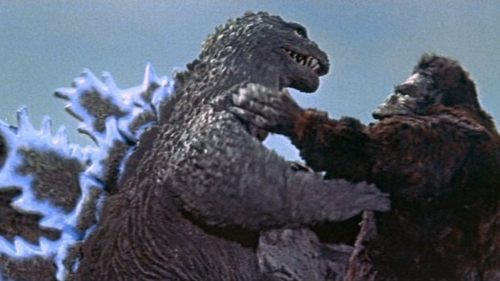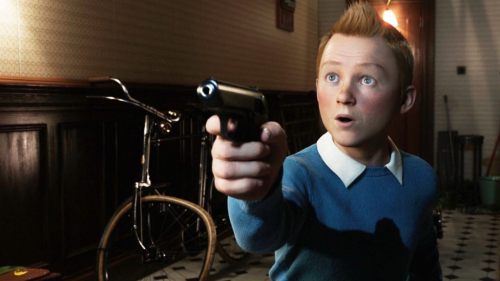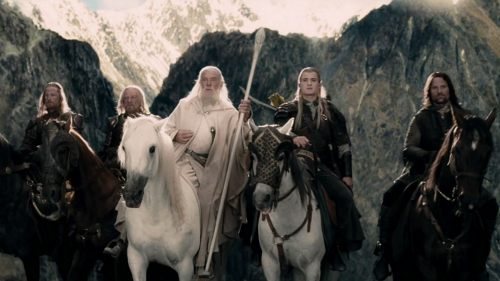The Badass Hall Of Fame: Andy Serkis
Almost a century ago Lon Chaney sat in his dressing room, applying make-up to transform himself into hundreds of extraordinary characters. The change that Chaney underwent wasn't just cosmetic, it was his whole body and essence that transmogrified. Anyone could wear the face of the Phantom of the Opera, but it took Chaney to make him real.
Were Lon Chaney alive today he would not be torturing himself with make-up appliances that contorted his face into grotesque visions. He would be torturing himself with skintight suits covered in balls that translated his body into digital magic, just as Andy Serkis does in his most amazing performances. In many ways Serkis is the inheritor of Chaney's legacy, an actor who completely subsumes himself into his role. It's just the tools that are different.
Serkis is a remarkable actor even when he's not being performance captured - check out his turn as Ian Dury in Sex & Drugs & Rock & Roll - but it's when he works with a team of digital artists that things get truly sublime. There are some actors who use the force of their own personality in their roles - Clint Eastwood will always be a version of Clint Eastwood in any part - but Serkis disappears inside the character. It's actually incredible to see in person; I've had the fortune to watch Serkis at work on Rise of the Planet of the Apes, and even without a single pixel on him he BECAME Caesar right there on set. Stooping, shuffling, hooting and hollering, Serkis may have been simply a man in a silly suit, but in the moment he became something much more.
Much of this must come from Serkis' theatrical training; actors get in front of an audience and transform an otherwise empty stage into other worlds. David Bowie played John Merrick in The Elephant Man onstage without a bit of make-up, but it was as utterly convincing as the most extravagant latex application. Acting is about finding truth, and that truth doesn't always need props and costumes.
What's exciting about the work that Serkis has been doing is that it allows him to find truth and humanity in non-human characters. Actors in ape suits have almost always been relegated to schtick performances, usually because the suits are never convincing. The original Planet of the Apes movies modified the look of the apes to make them more human, and to allow more acting through the make-up, but Serkis' Caesar is far more convincingly simian, thanks to the painstaking work of his collaborators at WETA. And make no mistake - they are collaborators, as Serkis is deeply involved in working with the technical people to create a standard of performance capture that will lead to best performances.
Serkis wasn't the first performance capture artist, but he was certainly the first to make us realize this was more than just 21st century rotoscoping. His performance as Gollum will one day be seen as ground zero in a revolution at the intersection of acting and special FX. Huge amounts of credit must be given to the animators at WETA, but it was really Serkis' acting as Gollum sat by a stagnant pool in The Two Towers, torn between loyalty and perfidy, that hit the moviegoing public in a way no performance capture ever had before.
Performance capture, in many ways, is the ultimate expression of how cinema works. We like to assign authorship because it makes it easier to judge, to appreciate and to discuss, but the reality of true cinema is that it's entirely collaborative. From top to bottom movies are made up of thousands of small choices and creative decisions, all overseen by the director but each made by the cast and the crew. Performance capture has the actor working with not only the script and the director, but in the best cases directly with the other actors as well. And from there the collaboration continues, as the animators and technicians work to turn the series of signals collected by their computers into a three dimensional, realistic character. But all of that visual realism is for nothing if there isn't a strong performance behind it all.
Serkis proved with Return of the King that his Gollum work was no fluke; if anything the character became even more nuanced, subtle and real as the technology advanced. The film's climax, with Frodo and Gollum battling to the death inside Mount Doom, could have been laughable, but the weight of emotion that Serkis brought to the character (who he also played de-digitilized, when Smeagol is a hobbit in the film's prologue) makes that final fight something incredible and moving and satisfying.
Serkis and WETA moved on to another incredible performance as the title character in King Kong. A few years later it becomes obvious the film doesn't hold up, but Serkis' work does. WETA's Kong is much more realistically a gorilla than the previous versions, and Serkis worked hard to bring legitimately simian movements and characteristics to his performance, but this is as far from Rick Baker in the 1976 ape suit as you can get. In many ways Serkis' performance outpaces the animation of the original model; the brilliant Willis O'Brien brought an astonishing amount of feeling to that claymation monkey, but Serkis brings real, complete soul.
Where Serkis triumps in King Kong is the way he keeps Kong an animal. This isn't an anthropomorphized performance, where Kong is just a hairy man. Serkis maintains the simian nature of the character but allows us into his emotions in the way that would be impossible with a real animal actor. It's a heartbreakingly beautiful performance.
This year Serkis truly advanced the art of performance capture to the next level in Rise of the Planet of the Apes. WETA technicians used a face-mounted camera to transpose Serkis' reactions and expressions onto the digital model of Caesar, a chimp whose advanced intelligence turns him into a Moses for monkeys.
Perhaps the greatest accolade you can give Serkis as Caesar is that you quickly forget the character is digital AND you forget he's a chimp. Caesar is just a character. The entire film rests on this; if WETA and Serkis hadn't been able to pull this off, Rise would simply not work. In fact early in the editing process many people behind the scenes thought the film DIDN'T work, and Fox was convinced they had a dud on their hands. But when the final WETA work came in the magnitude of what had been accomplished was clearly evident.
It's worth noting that Serkis has another great performance capture performance this month. He plays Captain Haddock in The Adventures of Tintin, and it was seeing his work there that convinced me Serkis was truly worthy of the Hall of Fame. He's playing - literally - a cartoon character, a silly drunken sea captain, but he invests the role with enough honest, true pathos that Haddock isn't just a sodden joke. You're rooting for him to get his shit together, to clean up and dry out, and it's not because it will aid the adventure - he's actually more helpful as a drunk - but because you like him. As a person. A cartoon person.
It's the way that Serkis is dedicated to performance capture as a craft that makes him a true badass. He works closely with the technicians behind the technology, making them understand what works for him as an actor. He makes himself available to his colleagues, helping them to navigate the strange waters of playing a digital character. And he has made himself the face of the process, refusing to let performance capture be seen as a second-rate job. Performance capture artists aren't just the tools of the FX department, they are full-fledged actors who are bringing characters completely to life.
I can't wait to see what Serkis does next with performance capture. He's returning to Middle Earth in The Hobbit, and it looks like there will be a sequel to Rise of the Planet of the Apes, but there is no limit on what kinds of characters Serkis could play via performance capture. If Lon Chaney was the Man of a Thousand Faces, Andy Serkis has the ability to be the Man of a Million Faces.



